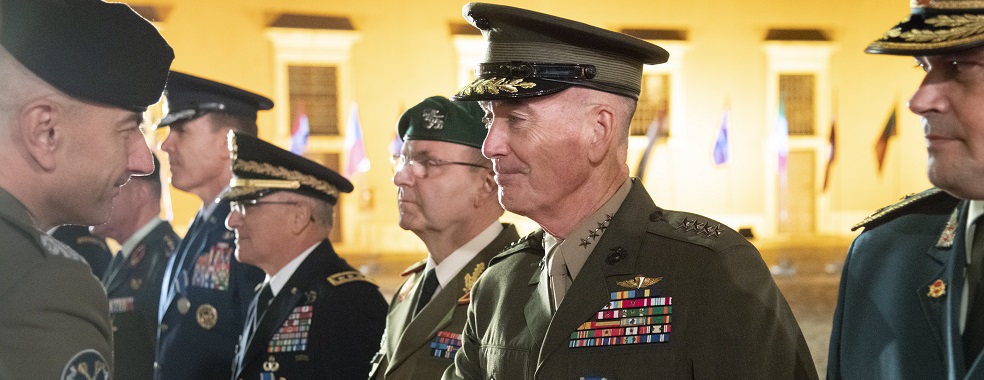Russia’s Strategy, ISIS’ Future & Countering China: CJCS Dunford Speaks
Posted on

Gen. Joe Dunford receives a decoration from Polish Lt. Gen. Rajmund Andrzejczak, chief of the general staff of the Polish Armed Forces.
Gen. Joe Dunford, Chairman of the Joint Chiefs Staff, spoke last week with a small group of traveling reporters after attending a conference of NATO Military Chiefs in Warsaw, including Breaking Defense contributor James Kitfield. Dunford described Russia’s strategy for pulling NATO apart and reiterated that Moscow poses the single greatest global threat to the UnIted States. Edited excerpts of that interview follow.
Q: How would you describe Moscow’s strategy?
Dunford: Russia has studied the United States since 1991 [at the end of the Cold War], and they know that the source of our strategic strength is the network of allies and partners that we have built over 70 years, and that operationally our strength is the ability to project military power. So I think Russia’s strategy is pretty simple: They want to undermine the credibility of the United States in terms of meeting its alliance commitments, and thus erode the cohesion of the NATO alliance. They also want to field capabilities to challenge our ability to project power into Europe. That’s why they’ve taken this small slice of land in Kaliningrad [on the Baltic Sea] and deployed anti-ship cruise missiles, anti-ship ballistic missiles, and air defense systems there. It’s an anti-access, aerial denial strategy aimed at challenging the Euro-Atlantic link.

James Kitfield
Q: Since Russia’s 2014 annexation of Crimea and military intervention in eastern Ukraine, NATO launched the European Deterrence Initiative; deployed four “Battle Groups” to frontline states in the Baltics and Poland; announced two new commands for reinforcing NATO forces in the event of an actual conflict; and adopted in principle Defense Secretary Jim Mattis’ readiness goal of having 30 battalions, 30 warships, and 30 squadrons of aircraft ready to deploy in 30 days. Is it fair to say that NATO has awakened from its post-Cold War slumber?
Dunford: I will tell you that [last week’s Military Chiefs] meeting was one of the most productive ever for this reason: three years ago there was not the appreciation we see today of the challenge posed by Russia and the threat of violent extremism. As a military leader it’s very easy now because we don’t have to debate those threats any more. We now have a very clear mandate to adapt NATO’s to confront those challenges. NATO is first and foremost about deterrence, and collective defense in the event that deterrence fails. All of our activities – our exercises, our training, and changes in our force posture – are designed to send a message, especially to Russia, that NATO has effective deterrence and collective defense capabilities.
Q: Do you see similarities between Russia’s actions in the Baltic Sea and China’s aggressive posture in the South China Sea, where Beijing is building artificial islands, militarizing them, and then claiming zones of exclusive sovereignty?
Dunford: There are clear similarities, because what Russia is trying to do vis-à-vis our allies and ability to project power, China is also trying to do. China is a rising power in the Pacific, and they have a fundamentally different form of government and some protectionist economic policies that have created friction in our relationship. I would broaden it even beyond the South China Sea, and tell you we’re seeing an erosion in the rules-based international order in the region. Along with our Pacific partners we share a commitment to a free and open Indo-Pacific based on international rules, norms and standards.
Q: How do you enforce those rules and norms in light of China’s actions?
Dunford: The military dimension is Freedom of Navigation operations that we conduct, along with 22 other nations. These are normal activities designed to demonstrate that the United States [military] will fly, sail and operate wherever international law allows. We’re not going to allow illicit claims to become de facto reality. That’s what (FON operations) are all about. Having said that, if you look at the stakes involved for both the United States and China, that argues for these issues being dealt with peacefully. There is absolutely no upside for either country in a major conflict.
Q: You mentioned the terrorism threat earlier. Do you believe the ISIS’ [Islamic State of Iraq and Syria] caliphate is all but defeated?
Dunford: If you look at the terrain they hold, the resources they command and the media capabilities they have today versus two years ago, it’s fair to say that ISIS is on their heels a bit. It’s also fair to say that we have had other extremist groups at this same stage, only to see them adapt and find other ways to try and advance their agendas. So we know the job is not completed yet.
Q: What is the next stage in the fight?
Dunford: I think ISIS will start to organize itself into a guerilla insurgency, rather than a more conventional force that tried to hold ground. They’ll look for opportunities to launch high-profile attacks, but probably focused more locally, because the pressure ISIS has been under over the last two years has disrupted its ability to conduct external operations. It’s just hard for its fighters to move around right now. In the meantime, the greatest challenge we face today is probably from individuals and homegrown violent extremists who are inspired by ISIS’ ideology.
Q: How important was it that Congress passed a bipartisan, $674 billion defense spending bill on time, without a continuing resolution or sequester caps kicking in?
Dunford: That was the first time that has happened in my 41-year career! (laughs) I think that reflects a commitment from the executive and legislative branches to give us the wherewithal to do our job. Now that we have a sufficient level of funding, my message to our legislative leadership is that the most important thing going forward is a sustained level of funding. Because it took us years to get into this fix where we couldn’t spend money efficiently, or be good stewards of our budget, because we lurched from year to year with fluctuating levels of spending. That didn’t allow us to be effective partners with the defense industry, for instance, because they need predictability in order to deliver [equipment and materiel] on time and at projected cost. No matter how big the defense budget is, every year we have to make choices. And we can make much better choices and prioritize better if we’re looking ahead three-to-five years informed by predictable funding levels.”
Subscribe to our newsletter
Promotions, new products and sales. Directly to your inbox.
